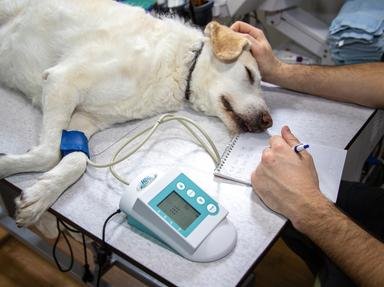Quiz Answer Key and Fun Facts
1. Only purebred dogs have problems with genetic disorders.
2. This disorder, found most often in the Bedlington terrier, is also known as Wilson's disease.
3. Found in many breeds, especially large ones, this is the most common inherited skeletal problem in dogs.
4. Found primarily in small breeds, but also in a few larger breeds such as the flat-coated retriever, this skeletal abnormality is also known as "slipping kneecaps."
5. This genetic abnormality is most common in white dogs.
6. Which of the following breeds does NOT have a high incidence of genetically-associated cancers?
7. This breed is subject to a genetic eye disorder that includes inadequate development of the blood vessels that nourish the retina, clefts in the optic disc, and retinal detachment. The effects on the dog range from no symptoms to blindness.
8. Perhaps the most common genetic eye defect in dogs has the acronym PRA. What does this stand for?
9. This is the most common endocrine system disorder in large-breed dogs.
10. This inherited bleeding disorder, named for the physician who discovered it, is found in many breeds of dogs.
11. This heart defect, most commonly seen in Newfoundlands and golden retrievers, can cause sudden death in an otherwise healthy dog.
12. This disorder, most commonly seen in the Doberman pinscher and Great Dane, causes weakness and incoordination of the legs, starting with the rear legs and gradually progressing to total paralysis.
13. We are all familiar with seeing tiny dogs- often white toy poodles or Maltese- that tremble continuously. Is this caused by a genetic disorder?
14. The most common inherited liver disorder in dogs is an abnormality of blood flow in the liver that leads to slow growth, neurological signs, vomiting, diarrhea and kidney stones. What is this disorder?
15. This disfiguring skin disorder affects Shetland sheepdogs and collies. The skin, especially on the face, tail tip, elbows, hips and toes, can be crusty, blistered and ulcerated, often resulting in permanent scarring. The underlying muscles can also be affected, causing atrophy.
16. Which of these breeds is subject to the most genetic disorders?
17. Now let's move on to how to prevent these disorders from occurring. First of all, is this a true statement?- If you wish to acquire a dog that is free of genetic disorders, then you are probably better off getting a purebred from someone who is just breeding one litter from their purebred but unregistered non-show dogs than from a breeder with show dogs, because the show dogs are likely to be inbred and have more problems.
18. Many pet stores sell puppies with guarantees against genetic disorders. These guarantees are helpful in ensuring a healthy pup.
19. One of the best ways to prevent genetic disorders is to screen the parent dogs to make sure that they are free of heritable problems. In the United States, one registry that records dogs free of specific diseases is the Orthopedic Foundation for Animals (OFA). For which disorders does OFA maintain databases of disease-free dogs?
20. At what age will OFA certify a dog as being free of hip dysplasia?
21. What US organization tracks dogs that are free of hereditary eye defects?
22. What hereditary defect can be detected by BAER testing?
23. What defects are detected by use of a Holter monitor?
24. When you are buying a dog just to be a pet, health testing is not important.
25. If you are planning on acquiring a purebred dog, which of the following should you do?
Source: Author
crisw
This quiz was reviewed by our editing team before going online.
Any errors found in FunTrivia content are routinely corrected through our feedback system.

